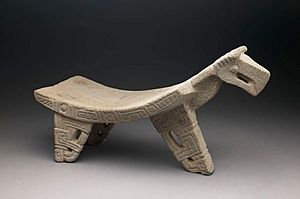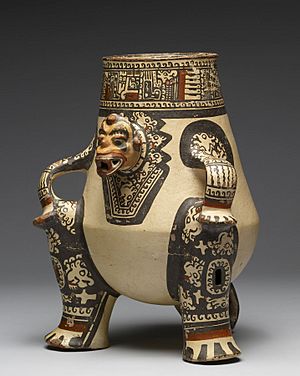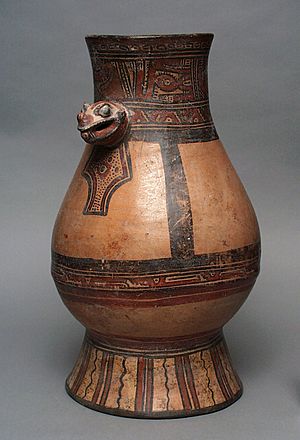Kingdom of Nicoya facts for kids

Imagine a powerful ancient kingdom in what is now Costa Rica! The Kingdom of Nicoya was a strong native nation. It covered a large part of today's Guanacaste Province. People also called it the Lordship of Nicoya.
Its main city, also called Nicoya, was on the Nicoya Peninsula. This city was the heart of the kingdom. It was important for politics, money, and religion. Many smaller villages and areas around the Gulf of Nicoya were part of it. In the 1500s, before Europeans arrived, Nicoya was the most important chiefdom in this part of Costa Rica.
Where Was Nicoya?
The Nicoya region is in the southern part of Mesoamerica. This is a historical area that includes parts of Mexico and Central America. Around 800 AD, new groups of people moved into Nicoya. They came from the north, from the Valley of Mexico. These groups were called the Chorotegas.
The Chorotegas settled in the Isthmus of Rivas in Nicaragua. They also took over much of Guanacaste, especially the Nicoya Peninsula. They replaced other local groups. Later, another group called the Nicaraos arrived. This caused the Chorotegas to move again. They settled on islands and the eastern side of the Gulf of Nicoya. This led them to connect with and influence native groups in central and southern Costa Rica.
A Rich History
The area of Guanacaste is part of a larger archaeological region. It's called Greater Nicoya. This region stretches from the Gulf of Fonseca in Honduras all the way to northern Costa Rica. Greater Nicoya was a thriving cultural center for about 2000 years.
Archaeological studies show that the Nicoyan society was very advanced. They had a complex social system. They also achieved a high level of cultural development. When the Spaniards arrived in the 1500s, they found well-organized cities. The people had strong governments. They also had special farming methods, including irrigation.
The Nicoyans were skilled artists and craftspeople. They were famous for three main things:
- Polychrome ceramics: These were colorful pottery pieces. Today, artisans in Guanacaste still make pottery using these old traditions.
- Jade jewelry: They created beautiful pieces from jade stone.
- Stone metates: These were special grinding stones, often with detailed carvings.
For 1200 years, the Nicoyan culture in Guanacaste was unique and strong.
What Does "Nicoya" Mean?
The name Nicoya came from the ruler of this nation. When the Europeans arrived, the king's name was Nicoya. The Spanish often named new lands after their leaders. This king was also known as Nicoa, Nicoián, or Nicoyán. The name seems to be a Spanish version of a native word.
There are a few ideas about what "Nicoya" means:
- Some think it comes from the Nahuatl word Necoclau. This means "country with water on both sides." This makes sense because the region is a peninsula, surrounded by water.
- Another idea is that Nicoya was a title for the kings. It might come from the Nahuatl phrase Necoc Yáotl. This means "with enemies on both sides." The Chorotegas often fought with their neighbors. These included the Nicarao people to the north. They also fought the Huetar Garabito Empire to the east. And they fought the people of Chira Island. All these groups wanted control of the peninsula and the gulf.
Necoc Yáotl is also a name for the Mesoamerican god Tezcatlipoca. In their beliefs, he was the god of battles. The Chorotegas and other Nahua peoples worshipped him. One way to show Tezcatlipoca was as a jaguar or a jaguar-man. This animal was often seen in Nicoyan art.
How Nicoya Was Ruled
The Kingdom of Nicoya had a special way of choosing its leader. They had an elective monarchy. This means the ruler was chosen, not born into the role. The Spanish called their leader a cacique. But in the local Mangue language, the ruler was called a mánkeme.
The mánkeme was chosen by a group called the monexico. This was a Council of Elders. The kingdom also had local lords called galpones. These lords ruled over a group of city-states or chiefdoms. It was like a federation, where different areas worked together.
See also
 In Spanish: Reino de Nicoya para niños
In Spanish: Reino de Nicoya para niños



